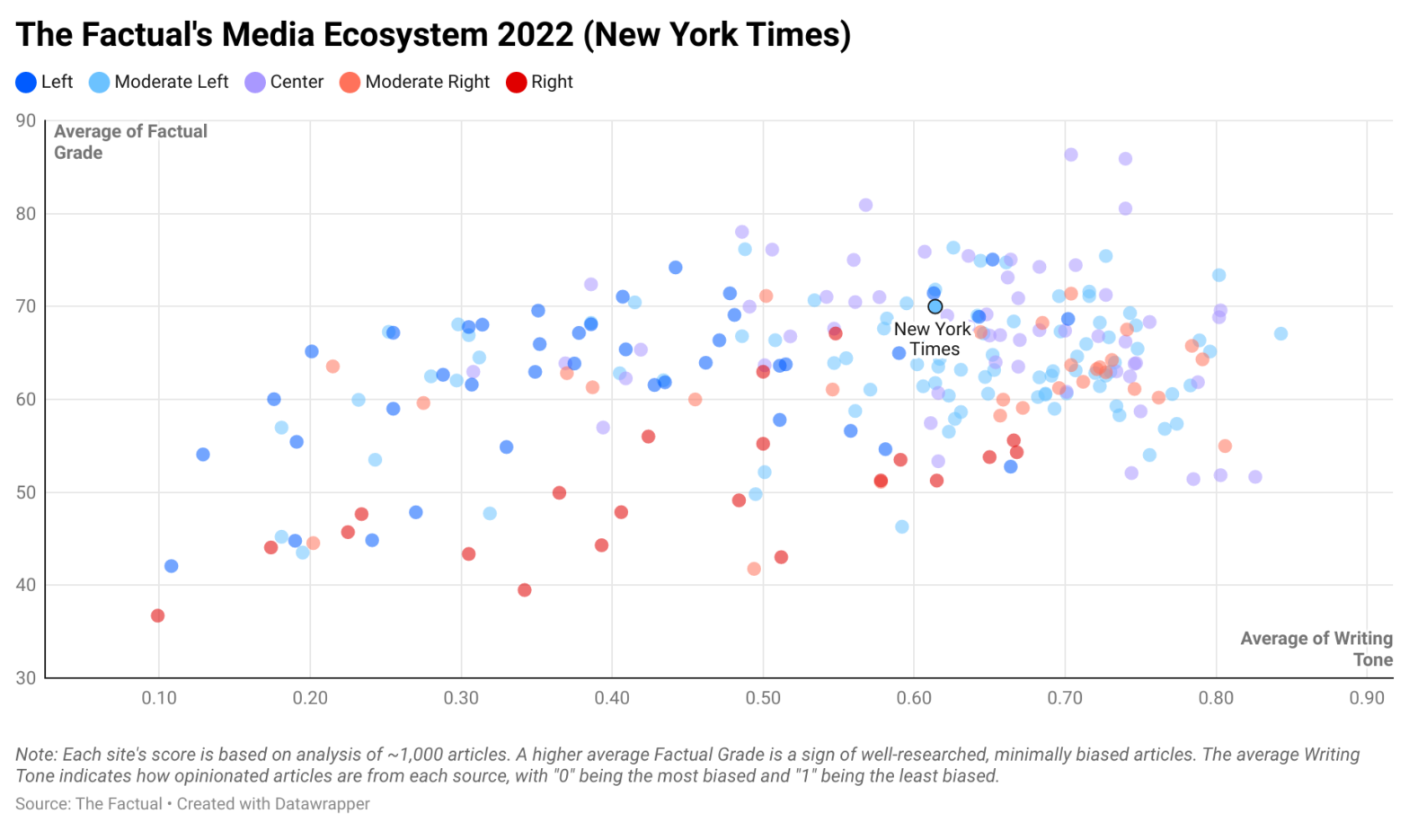The New York Times is one of the largest newspapers in the U.S. It has roughly 100 million registered users — readers who can only read a set number of articles per month — and its advertising department claims to reach an online audience of 164.2 million users globally. Recognized by many for its factual reporting, the newspaper also must contend perceptions of and questions about its liberal bias. How reliable is the New York Times and how biased is it?
How Does The Factual Rate News Sources?
The Factual analyzes more than 10,000 news stories every day to help readers find the most informative, least-biased articles. Our news-rating algorithm scores each article along four metrics: (1) cited sources and quotes, (2) publication history, (3) writing tone, and (4) author expertise. These scores combine in a weighted average we call a Factual Grade, which ranges from 0–100%. (See our How It Works page to learn more about our algorithm.)
For this study, we analyzed ~1,000 articles each from 240 news sources. The average Factual Grade for the entire dataset was 62.5%. Based on these averages, we can compare the performance of news sites across the media ecosystem. The entire dataset can be explored in greater detail here.
How Factual Is the New York Times?
The New York Times scored an average Factual Grade of 70.0%, placing it in the 83rd percentile in our dataset. The publication receives relatively high scores due to a combination of practices. First and foremost, articles tend to follow strong standards for sourcing of information, meaning they link to numerous, high-scoring external sources and tend to include relevant direct quotations. Likewise, authors for the New York Times exhibit significant topical expertise, indicating that the authors routinely cover the same topics. However, article scores are driven downwards by biased or opinionated language (see below).
Like any news source, scores for articles from the New York Times varied widely based on factors like author expertise and cited evidence. For example, some scored above 80%, while others scored below 50%.
Please check your email for instructions to ensure that the newsletter arrives in your inbox tomorrow.
One of the metrics The Factual uses is the Writing Tone, which measures how opinionated the writing is in an article. For this metric, the algorithm looks for signs of subjective commentary (e.g., first person pronouns and unnecessary adverbs), as well as the emotional nature of selected words, and sees how prevalent they are for a given length of text. More neutral text receives higher ratings, with “0” being the most opinionated and “1” being the most neutral.
The New York Times had an average Writing Tone of 0.61, placing it in the 49th percentile in our dataset for this metric. This suggests that articles from the publication tend to exhibit some biased and opinionated language. This can be seen in headlines such as “After Deadly Fires and Disastrous Floods, a Canadian City Moves to Sue Big Oil” and “Red-Hot Warehouse Market Faces a Reality Test.”
How Biased Is the New York Times?
The Factual classifies news sites by political bias as either Left, Moderate Left, Center, Moderate Right, or Right. This classification comes from third-party assessments from media bias organizations such as AllSides and Media Bias/Fact Check (MBFC). Based on this data, The Factual assigns the New York Times a Moderate Left bias.
AllSides rates the New York Times as “Lean Left,” based on survey data and over 67,000 ratings from the community. According to AllSides, “A plurality of respondents . . . rated The New York Times as Lean Left. A plurality of respondents who self-reported a personal bias of Right rated The New York Times as far Left.”
Meanwhile, Media Bias/Fact Check gives the paper a “Left-Center” rating, as well as a “High” rating for factual reporting. Such “Left-Center” sources “often publish factual information that utilizes loaded words to favor liberal causes.”
Editors for the newspaper have noted this bias, both recently and in years past. In answering the question “Is the New York Times a Liberal Newspaper?,” then-editor Daniel Okrent plainly replied “Of course it is.” In 2016, Liz Spayd, the current public editor, admitted the newspaper is “part of a fracturing media environment that reflects a fractured country” and that 65 percent of its readers possess “political values that were left of center.”
As a result, it is no surprise that the New York Times is criticized from the right. In recent years, the newspaper has been a lightning rod in some regards. Work like the 1619 Project, which looks at the legacy of slavery in the United States, are focal points of discussions on liberal “propaganda.” Other recent controversies include the resignation of a former writer and editor for the opinion section, over “bullying by colleagues” and an “illiberal environment,” as well as the backlash related to a Tom Cotton op-ed in the aftermath of George Floyd’s murder.
Please check your email for instructions to ensure that the newsletter arrives in your inbox tomorrow.
How to Mitigate Bias
News articles are bound to have bias because all authors have some frame of reference within which they describe a story. Political bias ratings are helpful in understanding this framing. However, it can be more beneficial to know how factual an article is based on quantifiable metrics that can be seen across the media ecosystem, such as cited evidence, author expertise, and writing tone. This is what The Factual ascertains.
Reading several, highly rated articles from across the political spectrum helps counter the bias of any news source or story. To have the day’s most factual news stories delivered to your inbox every morning, subscribe to our daily newsletter.
This article was updated on September 21, 2021 to reflect new data.

